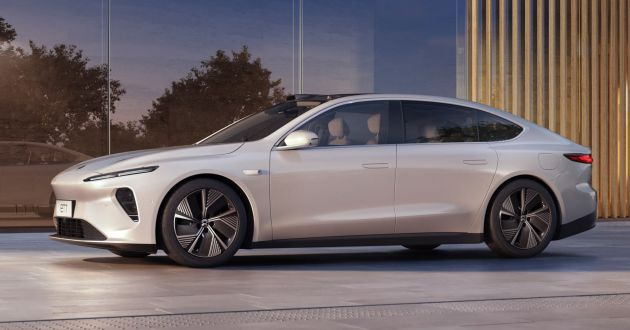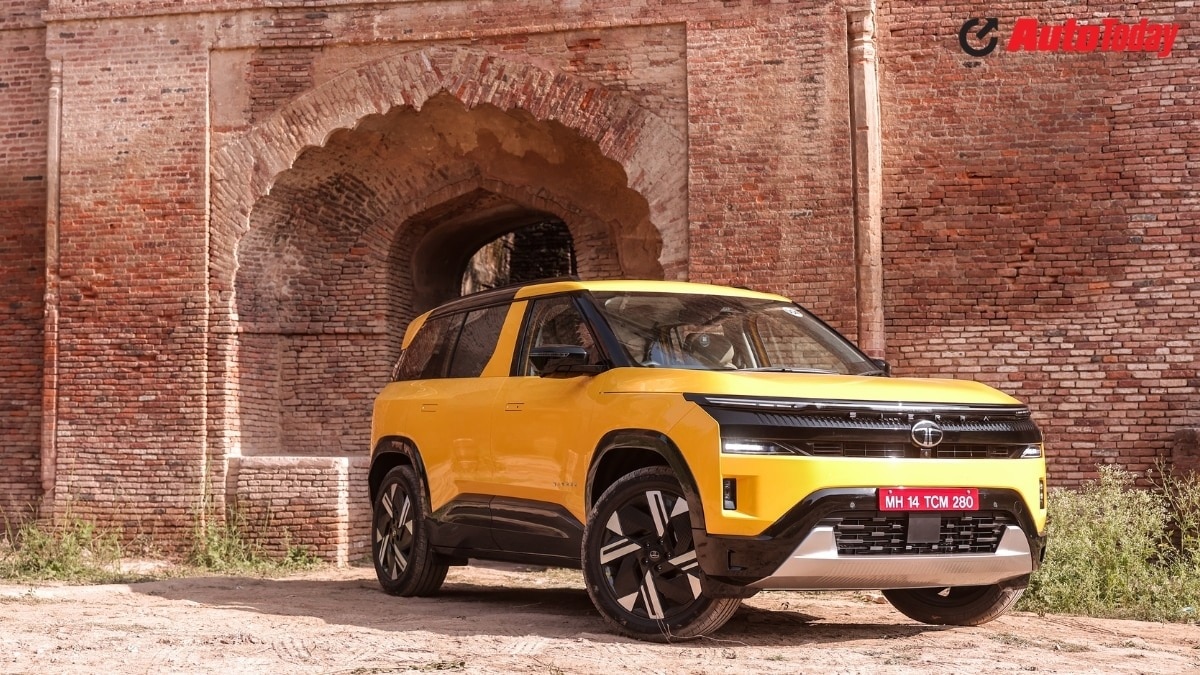Nio ET7 officially revealed with 653 PS and 150-kWh battery – over 1,000 km EV range; autonomous driving
Shanghai-based electric car maker Nio has revealed the new ET7 at its recent Nio Day 2020 event in Chengdu, China, and it certainly sounds very impressive on paper. However, it’ll be some time until customers get their hands on it, as the company is only accepting pre-orders for now, with deliveries estimated to begin in the first quarter of 2022.
The ET7 is a fully electric sedan that measures 5,098 mm long, 1,987 mm wide, 1,505 mm tall and has wheelbase that spans 3,060 mm. First previewed by the ET Preview concept from 2019, the final product bears a close resemblance to said show car, albeit with some notable revisions.
Up front, you’ll find an evolved version of the company’s signature X-bar face, which has been a staple on all its previous models like the EP9, EC6, ES6 and ES8. Cleaner in the terms of the design, there’s only one intake located at the base of the bumper, with the concept’s middle inlet being omitted entirely.
Two-bar LED daytime running lights also make up the front fascia, with cutouts beneath it to accommodate the dual-beam LED headlamps. Further changes from the ET Preview include a raised roofline, tweaked window line and less aggressive haunches, while the crease on the lower portion of the body has been restyled as well.
A full-width light bar at the rear forms the car’s taillights and helps to accentuate the fastback-like profile, the latter contributing to a drag coefficient of just 0.23. It’s certainly a sleek shape, only broken up by the numerous sensors that are linked to the ET7’s autonomous driving system (more on that later).
Inside, you’ll find a relatively minimalist cabin, with two displays standing out from the dashboard. These include a 10.2-inch digital instrument cluster and a 12.8-inch infotainment touchscreen featuring an AMOLED panel and a resolution of 1,728 x 1,888 pixels.
The infotainment system is powered by a third-generation Qualcomm Snapdragon system on a chip (SoC) that supports 5G, ultra-wideband (UWB), Wi-Fi 6, Bluetooth 5.2 and vehicle-to-everything (V2X) technology.
That circular object you see on the top of the dashboard is the company’s Nomi AI-powered digital assistant, and it comes with an array of four microphones and designed neural processing unit core to interpret and execute instructions.
Other quirks include trim inlays made from renewable rattan developed by Karuun. The company also touts “invisible smart air vents” in the gap above the Earth-friendly material, with further vents for the second row.
Standard equipment that Nio offers include a two-spoke steering wheel, a 23-speaker sound system with 1,000 watts of output, an air filtration system, air suspension, 4D Dynamic Control (navigation based active suspension) acoustic glass, along with heated, ventilated and massaging seats for both rows.
As for the electric powertrain itself, the ET7 uses a skateboard platform with a dual-motor setup that uses a silicon carbide (SiC) power module. The one at the front is rated at 245 PS (241 hp or 180 kW), while the rear gets a unit that serves up 408 PS (402 hp or 300 kW).
With a maximum output of 653 PS (643 hp or 480 kW) and 850 Nm of torque, the EV will get from zero to 100 km/h in 3.9 seconds. On the other hand, stopping from 100 km/h to a dead stop requires 33.5 metres thanks to the four-piston calipers that make up the Brembo brake system.


The battery pack located on the vehicle floor comes in several configurations, starting with a 70-kWh unit that provides over 500 km of range and followed by a 100-kWh unit for over 700 km. The largest and newest option is Nio’s 150-kWh battery pack, which will only be offered in late 2022, offering over 1,000 km of range – all figures are based on the NEDC standard.
The company didn’t provide charging times for the ET7, but referring to the official website, it’ll tale about seven hours for the 70-kWh pack to get from a 20-90% state of charge via 7 kW AC charging, and 2.5 hours with the 20 kW DC Power Home Plus wallbox. As for the 100-kWh pack, it’s 10 hours and 3.5 hours respectively. No times for the 150-kWh unit for now.
While plugging in is all well and good, Nio takes things a step further by fitting battery swap technology to its vehicles. The ET7 is no exception and there are currently 177 power swap stations in China that offer the service.
In conjunction with the ET7’s debut, the company also rolled out the second-generation of its power swap station, which can accommodate 13 batteries for a daily swap capacity of 312 batteries. The idea of it is pretty clever, as the car will automatically park into the station and with a push of a button, the entire battery pack is swapped out for a freshly charged one.
Through its Battery as a Service (BaaS) plans, owners can switch to different battery packs depending on their needs and budget. The company plans to increase the number of such stations to 500 by the end of 2021.
With all these technologies, the ET7 certainly sounds like a worthy and more advanced rival to the Model S, but there’s more. We now come to Nio Autonomous Driving (NAD), which is the company’s self-driving system that will be offered as a subscription to customers for 680 yuan (RM424) a month.
On the ET7, the hardware required for the system to work, which Nio calls Aquila Super Sensing, comes as standard. Remember those extra appendages stuck on the exterior? Well, they are part of 33 sensing units that include 11 eight-megapixel cameras, one ultralong-range LiDAR sensor, five millimeter-wave radars, 12 ultrasonic sensors, high-precision positioning units, V2X and the interior Advanced Driver Monitoring System (ADMS).
The company says the ET7 has 19 safety and driver assistance features available via subscription and adds that “NAD brings safer and more relaxing autonomous driving from point A to point B, gradually covering use cases from expressways and urban parking to battery swapping.” Given the sheer number of sensors and claimed functions, NAD should humble Tesla’s Autopilot and could achieve Level 4 autonomous driving capability by 2022.
To process all the information streaming at a throughput of 8 GB per second from these sensors, there’s the ET7’s brain called Adam, and it is powered by four Nvidia Orin SoCs. Of the four, two are master cores, one is for redundancy, while the fourth is dedicated to crowd AI and personalisation. Altogether, Adam has 48 A78 CPU cores, 256 third-generation Tensor AI cores, 8,096 CUDA cores, 68 billion transistors and is capable of 1,016 trera operations per second (TOPS).
Nio is currently accepting pre-orders for the ET7 with a 5,000 yuan (RM3,118) deposit, which nets customers a 10,000 yuan (RM6,235) reduction from the purchase price. Existing owners who want in will also be offered discounts, along with membership points through the Nio app.
Prices start at 448,000 yuan (RM279,253) for the 70-kWh variant and 506,000 yuan (RM315,455) for the 100-kWh variant. With the BaaS plan, the price drops to 378,000 yuan (RM235,663) for both, although customers will need to pay an additional 980 yuan (RM611) and 1,480 yuan (RM923) per month, respectively.
The 100-kWh option also comes in a Premier Edition, which adds a Nappa leather interior, 20-inch Performance wheels and Nomi Mate 2.0 for 526,000 yuan (RM327,984), or 398,000 yuan (RM248,170) plus 1,480 yuan (RM923) monthly.






























The post Nio ET7 officially revealed with 653 PS and 150-kWh battery – over 1,000 km EV range; autonomous driving appeared first on Paul Tan's Automotive News.
from Paul Tan's Automotive News
Read The Rest:paultan...







Post a Comment